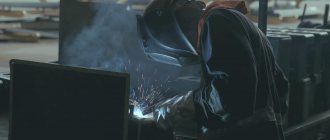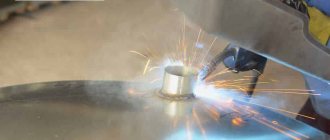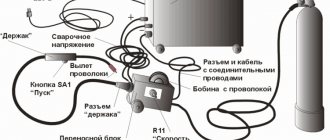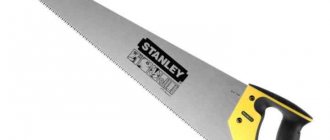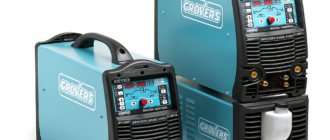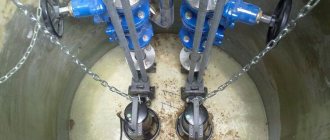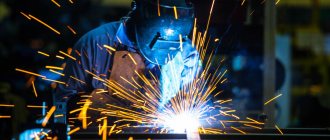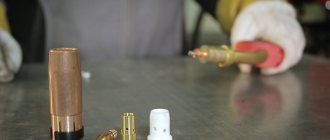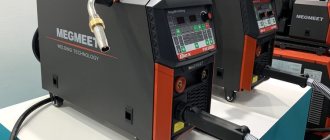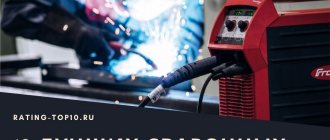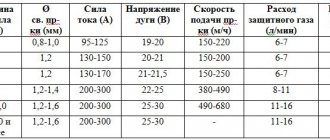Welding (electrode) wire is an indispensable material used when connecting metal surfaces. Thanks to it, stable intermolecular bonds of the joining surfaces are formed, creating a strong weld. Since the parts to be welded are subsequently subjected to intensive use, the choice of filler component should be taken with full responsibility. We invite you to find out which welding wire is optimal for a semi-automatic machine.
Types of electrode wire. Their operating principle
Depending on the semi-automatic welding method, the wire can be used:
- In a protective gas environment.
Welding can be carried out using inert (without carbon dioxide) and active (with carbon dioxide) gases. According to GOST No2246-70, with this technology 75 grades of wire can be used, which can be used to connect almost all metals. Semi-automatic welding of cast iron, zirconium, aluminum, magnesium, titanium, etc. is especially popular.
semi-automatic welding in a protective gas environment
Wire melting occurs with the help of an arc that is formed between the electrode and the metal part. During this, the weld pool is filled with gases, which displace air, which deteriorates the quality of the weld. To prevent pores from forming in the welding seam, the shielding gas pressure should be 0.6 - 0.8 MPa. For stable arc burning and low energy consumption, filler wire with a diameter of 0.5 - 3 mm is used.
- Without using gas (FLUX).
semi-automatic welding with flux-cored wire without gas
Flux-cored, also self-protecting, wire for semi-automatic is useful for mounting large structures, especially if the parts being welded are difficult to reach. Fluxed wire is needed when joining non-ferrous metals, their alloys, low-carbon steel, and steel with any degree of alloying. The most common consumable diameters are 2 mm, 5 mm and 8 mm.
Flux-cored welding wire for semi-automatic machines melts under the influence of the welding arc. At the same time, the metal surface melts. The depth of penetration depends on the thickness of the wire and the applied current. A weld pool is formed, covered with a thin layer of slag. Once the arc is removed, the molten material crystallizes to form a seam joint, and the remaining slag can be cleaned out. It is important that the flux-cored wire contains as few chemicals as possible that release toxins when reaching high temperatures.
Types of products for semi-automatic machines
Filler materials are classified according to the following criteria:
- Scope of application. Products can be universal or highly specialized. The second type is used when working underwater or in space, assembling reinforcement cages. The first group is intended for general construction and floating operations.
- Rod structure. Products may have a solid, powder or activated core.
- Type of external covering. The additive can be simple or copper-plated. Self-shielded wire is used for welding low-alloy or carbon steel.
- Physicochemical characteristics. Explained by the concentration of alloying additives.
Copper-clad wire
The product is used when connecting parts made of low-alloy and low-carbon steel types. When metals melt, they react with oxygen, and an oxide deposit forms on the surface, reducing the strength of the joint. This effect can be eliminated by applying a copper coating to the surface of the electrode. The casing is corrosion resistant and forms a protective shell around the seam. The copper-plated electrode is used in combination with gas equipment.
Its main advantages include:
- high quality of the resulting seam;
- increased anti-corrosion protection;
- possibility of use during surfacing operations;
- low cost.
Flexible stainless steel
Products of this type are highly resistant to oxidation. They can have a round, oval, hexagonal, or square cross-section.
Flexible stainless steel rods are used for welding the following structures:
- medical instruments and equipment;
- oil pipelines, hydrocarbon storage tanks;
- equipment used in the metallurgical industry.
The composition of the flexible product is approved by GOST 18143-72.
Aluminum products
This type of consumable material is characterized by increased strength, oxidation resistance, and ductility. It is designed for connecting parts made of aluminum and alloys based on it. Magnesium, manganese, and silicon are used as alloying additives in the manufacture of electrodes. Welding is carried out in a protective gas atmosphere. After opening the package, you need to start working immediately, because the wire begins to oxidize, which negatively affects the quality of the seam.
We recommend reading Instructions for choosing and using cold welding for plastic
Powder additives
This element looks like a hollow tube. The internal space is filled with powder and flux. The composition helps protect the welded joint from oxygen and slag. Ensuring the safety of the welder is also an important factor. The inclusion of flux powder speeds up the ignition of the arc and reduces the likelihood of spatter formation. The use of this type of electrodes does not require the creation of a gaseous environment.
Other non-ferrous metals
To work with copper, brass and aluminum, specialized wire is designed, made from the corresponding metals. The production of such electrodes is regulated by GOST 7871-85, according to which the diameter of the element should be 0.8-12.5 mm.
Activated product
It is a type of powder electrodes. The shell is made from steel grade 08G2S. Features increased thickness. The cavity contains powdered flux, its mass does not exceed 7%. The wire is used for welding in an inert gas environment. The filler contains salts of alkaline earth metals. The special chemical composition promotes stable burning of the electric arc.
Welding wire marking
When deciphering the marking of welding wire for semi-automatic machines, be sure to focus your attention on the beginning of the code, where the thickness of the product is indicated. The following letter abbreviation is an indication of the purpose of the wire: surfacing (Np) or welding (Sv). Then, in some cases, it states how much carbon the material contains. This number is hundredths of a percent.
The letters A and AA indicate the degree of purity of the wire from phosphorus, sulfur, and other harmful impurities. The letters following them indicate alloying elements, such as molybdenum (M), silicon (C), nickel (N), chromium (X), zirconium (C), copper (D), vanadium (F), titanium (T) , manganese (G), aluminum (U). If a number is then added, it indicates the percentage presence of the element. If there is no number, then the wire contains no more than 1 percent of this element.
Then it is written down how the wire was smelted: VI - in vacuum induction furnaces, VD - in vacuum arc furnaces, Ш - using electroslag remelting. The additional designation E is given when electrodes can be made using wire. To indicate the copper-plated surface of the product, the marking contains the letter O. Finally, the state standard to which the product conforms must be indicated.
Wire markings for semi-automatic machines
Filler material belongs to the category of industrial products, the technical characteristics of which are regulated by GOST. The standard adopted in 1973 is still in use today. The marking contains basic information about the product.
Its components can be deciphered using the example of wire SV08G2S:
- The first 2 letters indicate the purpose of the product. SV – material for welding work.
- The next 2 symbols indicate the carbon concentration. In the case under consideration, it does not exceed 0.08%.
- The letter and number below indicate the manganese content (2%).
- The last symbol indicates the presence of silicon in the composition. If there is no number after the letter, the content of the element does not exceed 1%. If O is present in the marking, the product is copper-plated.
The total amount of alloying additives in the composition of the product in question exceeds 2.5%.
SV08G2S wire is most often used in conjunction with automatic and semi-automatic devices.
We recommend reading: Do-it-yourself cold and hot welding of linoleum
Aluminum wire for semi-automatic machine
Semi-automatic aluminum welding wire is used in cases where it is necessary to connect surfaces made of aluminum and its alloys in a shielding gas environment. In addition to aluminum itself, the consumable material contains iron, silicon, manganese and magnesium. The welding process is quite complicated, since aluminum has a lower melting point than the oxide film formed on its surface. It is extremely important to select a higher welding current; current collecting tips must have a larger hole diameter.
Wire for semi-automatic welding of aluminum is widely used in industry (especially food industry), shipbuilding and aircraft construction. You can make T-joints, butt seams, and also overlap metal sheets. High-quality aluminum wire for a semi-automatic machine, in addition to fusibility, must have the following characteristics:
- Excellent electrical and thermal conductivity.
- A small mass.
- Low biological activity.
- Resistant to moisture and aggressive environments.
- Strength.
- Flexibility.
- Long shelf life.
The interstate standard assumes that aluminum welding wire for semi-automatic machines is manufactured with increased strength (ATp), hard (AT), semi-hard (ATP) and soft (AM). When welding with aluminum wire for a semi-automatic machine, you should ensure that the arc length does not exceed 12-15 mm. Otherwise, it is likely that the metal will be burned through.
For welding aluminum semi-automatically without gas, flux-cored filler wire is suitable. However, keep in mind: it imparts some porosity to the weld, so it is better for welding products that are not subject to intense load.
Copper-clad wire
Copper wire for semi-automatic welding is used in cases where it is necessary to weld carbon and low-alloy steel in a shielding gas environment. It is used in industry, in the production of water and land transport, installation of pipelines, in the production of railway cars, installation of structures that will be operated under changes in temperature and pressure.
Copper wire allows you to obtain a strong seam that is not subject to corrosion and can withstand prolonged mechanical stress. High impact strength and crack resistance are guaranteed if the amount of copper in the wire is no more than 0.25% and the coating thickness is no less than 6 microns. No less important advantages are the following:
- Excellent power supply.
- Metal does not splash.
- Stable and uniform supply of consumables.
- Slight abrasive wear on the current supply tip.
- Aesthetic appearance.
When choosing wire, carefully check the quality of the winding. If the turns do not fit tightly together, the product may be deformed, and then it will “stick” in the welding machine. To avoid exposure to moisture, the wire should be stored by wrapping the cassette in inhibitor paper.
Copper welding technology can be found here.
Rating of the best welding wire manufacturers
Russian manufacturers
5.SMS SV-08G2S-Ultra 1.2 mm to 300
The Russian company SvarMontazhStroy presents Sv08G2S Ultra rod, 1.2 mm in diameter, for connecting parts made of low-carbon steel grades semi-automatically in all spatial positions, non-copper-plated, with improved surface treatment. The work is performed in a gas environment. The best results are shown by protection with pure carbon dioxide or a mixture of gases from CO2 (20%) and argon (80%). The product is sold on a K 300 reel, in a package weighing 18 kg. The average price is 96 rubles.
welding wire SMS SV-08G2S-Ultra 1.2 mm to 300
Advantages:
- the diameter of the rod is suitable for working with parts of different thicknesses;
- affordable price.
Flaws:
- not identified.
4.ChZSM Sv-08G2S OM 1.2 mm
The Cherepovets Welding Materials Plant produces a wide range of products, including copper-plated solid wire with a diameter of 1.2 mm. A classic version of consumables for assembling structures from low-alloy and low-carbon steels in accordance with GOST 2246-70. The manufacturer recommends pure CO2 or mixed with argon (80%) as a shielding gas. The average price is 1999 rubles for a package weighing 18 kg.
welding wire ChZSM Sv-08G2S OM 1.2 mm
Advantages:
- high quality surface;
- stable diameter;
- convenient packaging;
- affordable price.
Flaws;
- not identified.
3.SZSM Sv-08G2S 1.0 mm D 300
Solid wire for connecting steel parts from the Moscow region enterprise SvarStroyMontazh. The brand is the same as the three previous ones in our review - the classic Sv-08G2S, 1.0 mm in diameter, copper-plated, on a D 300 reel. Designed to work on semi-automatic devices. Does not “stick” to the parts being welded, reduces the formation of “spatter”. Due to the high quality of the surface, the rod is fed into the weld zone smoothly, without jerking. The average price is 2174 kg per 15 kg spool. For one kilogram you will have to pay 144.9 rubles. This is slightly higher than the previous two options.
welding wire SZSM Sv-08G2S 1.0 mm D 300
Advantages:
- smooth feed;
- the rod does not “stick”.
Flaws:
- overpriced.
2.PSG - 0302 D 300 ESVA
Under this designation, Elektrosvarka JSC (Kaliningrad region) produces the filler material Sv-08G2S, already known to us. Solid rod for welding products made of low-alloy and low-carbon steels, with carbon content ranging from 0.05 to 0.11% and Manganese from 1.8 to 2.1%, with copper coating, thickness up to 0.30 microns. The assortment includes rods with a cross-section from 0.8 to 1.6 mm, in-line winding on reels of 5.15 and 18 kg. The feed is smooth, thanks to the high-quality surface and stable cross-section. The packaging is sealed. For a consumable coil with a diameter of 0.8 mm and weighing 15 kg, the buyer will pay 2207 rubles, i.e. 147 rubles per 1.0 kg. This is the average price.
welding wire PSG - 0302 D 300 ESVA
Advantages:
- lasting;
- deviations from the diameter are minimal;
- high quality coating.
Flaws
- overpriced.
1.Bars ER-70S-6 0.8 mm
Rod for welding steel parts from the Russian brand Bars. Marking ER-70S-6 according to AWS, according to GOST 2246-70 corresponds to mark Sv-08G21S. According to the manufacturer’s recommendation, work should be carried out in a protective gas environment, which is recommended as pure CO2 or its mixture with argon. Used in the assembly of ships, cars, bridges and high-pressure cylinders. The average price for a reel weighing 5 kg will be 935 rubles, therefore, one kilogram of goods will cost the buyer 187 rubles. This is the highest price for a similar consumable from other Russian manufacturers.
welding wire Bars ER-70S-6 0.8 mm
Advantages:
- no deviations from the section;
- high quality copper plating;
- convenient packaging.
Flaws:
- the price is very high.
Foreign manufacturers
5.ELITECH 0606.016000 0.8
Chinese manufacturer with Russian roots. The product in question is a flux-cored wire for submerged arc welding. You can work without gas. The diameter has minimal deviations from the nominal value, equal to 0.8 mm. The total weight of the reel is 1 kg. The average price is 908 rubles.
welding wire ELITECH 0606.016000 0.8
Advantages:
- small packaging is convenient for the retail buyer;
- working with flux does not require weld protection with inert gas;
- affordable price.
Flaws:
- Deviations from the nominal diameter that are greater than permissible are possible.
4.DEKA ER70-6 0.8mm
Another manufacturer from China is represented in our review by the most popular consumable among welders, Sv-0.8G2S. This is a solid wire for welding greasy structures, with a copper coating, with a cross-section of 0.8 mm. Work should be carried out in an inert gas environment. Pure CO2 or mixed with argon. The average price for a 5.0 kg reel is 890 rubles.
welding wire DEKA ER70-6 0.8mm
Advantages:
- high-quality coating;
- stable section;
- affordable price.
Flaws:
- not identified.
3.Lincoln Elektric Sv-08G2S 0.8 mm
The American company produces a fairly wide range of rods, including the Sv-08G2S, which is in high demand. The popularity of the brand is explained by its wide range of applications and welding in all positions. The average price of a five-kilogram reel is 1,334 rubles or 266.8 rubles/kg.
welding wire Lincoln Elektric Sv-08G2S 0.8 mm
Advantages:
- high quality;
- wide range of applications.
Flaws:
- high price.
2.ESAB Sv-08G2S 0.8 mm
Another example of such a popular brand in the world, this time from the world leader in the production of welding materials, the international company ESAB. The advantages of this brand have already been sufficiently described in our review. It remains only to note the excellent quality of the product manufactured by ESAB. According to welders, there is no better manufacturer in the world. The average cost of a 5 kg reel will be 1334 kg, i.e. per kilogram you will have to pay 266.8 kg.
welding wire ESAB Sv-08G2S 0.8 mm
Advantages:
- rigidity;
- no deviations in the cross-section;
- copper-plated surface.
Flaws:
- high price.
Stainless steel wire for use in semi-automatic welding
Semi-automatic stainless steel welding wire best welds alloy steels, which are joined using gases that prevent oxidation. Stainless steel welding wire is used in metallurgy, oil refining, food industry, medicine, chemical industry, automobile manufacturing and other areas of life. It is often necessary to reliably connect stainless steel surfaces in domestic conditions - for example, when installing fences or constructing frames for a greenhouse.
To ensure that the seam is protected from oxidation, stainless steel is saturated with impurities of phosphorus, nitrogen, chromium, manganese and carbon.
Stainless steel wire for semi-automatic machines has the following advantages:
- It flows evenly into the semi-automatic machine.
- Provides a strong, pore-free seam.
- Has a dense in-line winding.
- High performance guaranteed.
- The amount of smoke is minimal.
The wire for welding stainless steel semi-automatically with gas limits the choice of polarity used during operation: you need to choose the opposite one. If you plan to use stainless flux wire, then straight polarity is required.
Flux cored wire for semi-automatic machine
Flux-cored wire for semi-automatic machines, also known as flux-cored wire, is used without protective gas. It is made in the form of a tube that contains flux. Its weight can range from 15 to 40% of the product weight.
Flux wire can be used for welding on stainless steel, aluminum, copper, titanium, and steel. In addition to semi-automatic welding under normal conditions, this wire is used for welding under water, connecting reinforcement, and forcibly creating a seam. However, according to professionals, it is impossible to fill a hollow tube with powder if there are no pores in it. Therefore, it cannot be guaranteed that the welding zone will be completely continuous and super strong. In addition, it is necessary to thoroughly clean metal surfaces from the resulting slag. Used primarily in the down position.
With all its shortcomings, you need flux-cored wire for a semi-automatic machine without using gas if:
- It is planned to use high current density (approximately 200 A per mm2),
- You have a lot of work ahead of you.
Helpful tips when choosing welding wire
In order for semi-automatic welding to guarantee a high-quality result, and the work does not have to be redone several times, you need to take a responsible approach to the choice of wire.
An incorrectly selected chemical composition, as a rule, causes a difference in melting temperatures. Wire that melts later than the metal surface cannot create a high-quality seam. When purchasing welding wire for semi-automatic machines, consider:
- Purpose. Manufacturers place instructions on the packages for which metals it is better to use one or another brand. It is necessary to listen to these recommendations.
- Diameter. This indicator depends on the thickness of the parts being welded.
wire packaging for semi-automatic machine
- Amount in a package. Consumables are sold in rolls of 1 kg, 5 kg (for semi-automatic devices used in everyday life); 15 kg, 18 kg (for professional welding devices).
- Melting point. Must be below the melting temperature of the part.
- Appearance. The surface of the product must be clean and free of rust, paint stains or machine oil.
How to choose welding wire
Types of welding wire
. In total, there are about 80 brands of welding wire in Russia. Experts distinguish 3 varieties.
- Low alloy contains no more than 2.5% alloying additives in the composition. There are 6 brands of such material sold on the market.
- Alloyed welding wire includes material with a concentration of alloying additives in the range of 2.5-10%. The retail chain offers about 30 brands of wire.
- Highly alloyed contains over 10% alloying components. There are more than 40 grades of material.
Chemical composition
. When choosing a welding wire, experts advise first of all to pay attention to the identity of the chemical composition of the material being joined and the electrode.
- Particular attention should be paid to carbon concentration. The lower the content of this element, the more plastic the seam turns out.
- The presence of chemical elements such as phosphorus and sulfur in the composition has a negative impact on the quality of the weld.
Melting temperature
. Another important requirement for welding wire when choosing. This is the melting point. Experts believe that this parameter should be similar or slightly lower than that of the metals being joined. The accuracy of the seam will depend on the uniform melting of the wire electrode. If the melting temperature is chosen incorrectly, cracks and slag appear in the weld, and burns form on the parts being welded.
General requirements
. To achieve a strong and durable connection between metal workpieces, you should pay attention to several nuances.
- The diameter should be comparable to the thickness of the parts being connected.
- The surface of the wire should be free of scale, rust, traces of paint, oil stains and other contaminants.
- Carbon dioxide, helium, argon, a mixture of carbon dioxide and argon are used as a protective atmosphere. If problems arise with equipping the welding machine with inert gas, then it is better to purchase flux-cored wire. During the combustion process, it creates a protective environment in the welding zone.
We have selected 9 of the best welding wires for review. All of them are sold in the Russian retail chain. When allocating places, the opinion of the expert community and reviews of domestic welders were taken into account.
